ALH Inhibition as a Molecular Initiating Event in the Adverse Outcome Pathway of Benomyl Toxicity in Caenorhabditis elegans: Relevance for Parkinsonism
Abstract
1. Introduction
2. Results
2.1. Physiological and Morphological Parameters
2.2. Aldehyde Dehydrogenase Functionality and Redox Indicators
2.2.1. Aldehyde Dehydrogenase Activity
2.2.2. Aldehyde Dehydrogenase Localization and Relative Abundance
2.2.3. Catalase and Superoxide Dismutase Activity
2.2.4. Lipid Peroxidation
2.3. DA Functionality Assessment
2.3.1. Basal Slowing Response
2.3.2. Dopaminergic Neuron Morphology
2.3.3. Optogenetic Stimulation
2.4. Expression of the alh-1 Gene in Dopaminergic Neurons
3. Discussion
4. Materials and Methods
4.1. Animals and Strains
4.2. Exposure Protocol
4.3. Physiological and Morphological Parameters
4.3.1. Lethality
4.3.2. Growth
4.3.3. Reproduction
4.4. Aldehyde Dehydrogenase Functionality and Redox Indicators
4.4.1. ALH Activity
4.4.2. Aldehyde Dehydrogenase Localization and Relative Abundance
4.4.3. Catalase
4.4.4. Superoxide Dismutase
4.4.5. Lipid Peroxidation
4.5. DA Functionality Assessment
4.5.1. Basal Slowing Response
4.5.2. Dopaminergic Neuron Morphology
4.5.3. Optogenetic Stimulation
4.6. Expression of the alh-1 Gene in Dopaminergic Neurons
4.7. Statistical Analysis
5. Conclusions
Supplementary Materials
Author Contributions
Funding
Institutional Review Board Statement
Informed Consent Statement
Data Availability Statement
Acknowledgments
Conflicts of Interest
References
- Enserink, M.; Hines, P.J.; Vignieri, S.N.; Wigginton, N.S.; Yeston, J.S. The Pesticide Paradox. Science 2013, 341, 728–729. [Google Scholar] [CrossRef] [PubMed]
- Jaga, K.; Dharmani, C. The Epidemiology of Pesticide Exposure and Cancer: A Review. Rev. Environ. Health 2005, 20, 15–38. [Google Scholar] [CrossRef] [PubMed]
- Kara, M.; Oztas, E.; Ramazanoğulları, R.; Kouretas, D.; Nepka, C.; Tsatsakis, A.M.; Veskoukis, A.S. Benomyl, a Benzimidazole Fungicide, Induces Oxidative Stress and Apoptosis in Neural Cells. Toxicol. Rep. 2020, 7, 501–509. [Google Scholar] [CrossRef]
- Zhou, J.; Xiong, K.; Yang, Y.; Ye, X.; Liu, J.; Li, F. Deleterious Effects of Benomyl and Carbendazim on Human Placental Trophoblast Cells. Reprod. Toxicol. 2015, 51, 64–71. [Google Scholar] [CrossRef]
- Kawaratani, Y.; Matsuoka, T.; Hirata, Y.; Fukata, N.; Nagaoka, Y.; Uesato, S. Influence of the Carbamate Fungicide Benomyl on the Gene Expression and Activity of Aromatase in the Human Breast Carcinoma Cell Line MCF-7. Environ. Toxicol. Pharmacol. 2015, 39, 292–299. [Google Scholar] [CrossRef]
- Rathinasamy, K.; Panda, D. Suppression of Microtubule Dynamics by Benomyl Decreases Tension across Kinetochore Pairs and Induces Apoptosis in Cancer Cells. FEBS J. 2006, 273, 4114–4128. [Google Scholar] [CrossRef]
- Bellisai, G.; Bernasconi, G.; Brancato, A.; Carrasco Cabrera, L.; Ferreira, L.; Giner, G.; Greco, L.; Jarrah, S.; Kazocina, A.; Leuschner, R.; et al. Reasoned Opinion on the Toxicological Properties and Maximum Residue Levels (MRLs) for the Benzimidazole Substances Carbendazim and Thiophanate-methyl. EFSA J. 2021, 19, e06773. [Google Scholar] [CrossRef]
- Gupta, K.; Bishop, J.; Peck, A.; Brown, J.; Wilson, L.; Panda, D. Antimitotic Antifungal Compound Benomyl Inhibits Brain Microtubule Polymerization and Dynamics and Cancer Cell Proliferation at Mitosis, by Binding to a Novel Site in Tubulin. Biochemistry 2004, 43, 6645–6655. [Google Scholar] [CrossRef]
- Alejandro, M.-N.M.; Guadalupe, B.-E.; Omar, T.-S.F.; Patricia, R.-R. Temporal and Spatial Analysis of Benomyl/Carbendazim in Water and Its Possible Impact on Nile Tilapia (Oreochromis Niloticus) from Tenango Dam, Puebla, Mexico. Environ. Monit. Assess. 2022, 194, 23. [Google Scholar] [CrossRef]
- Manasa, K.; Chitra, V. Phytoconstituents in the Management of Pesticide Induced Parkinson’s Disease—A Review. Biomed. Pharmacol. J. 2019, 12, 1417–1424. [Google Scholar]
- Staub, R.E.; Quistad, G.B.; Casida, J.E. Mechanism for Benomyl Action as a Mitochondrial Aldehyde Dehydrogenase Inhibitor in Mice. Chem. Res. Toxicol. 1998, 11, 535–543. [Google Scholar] [CrossRef]
- Jackson, B.; Brocker, C.; Thompson, D.C.; Black, W.; Vasiliou, K.; Nebert, D.W.; Vasiliou, V. Update on the aldehyde dehydrogenase gene (ALDH) superfamily. Hum Genomics. 2011, 5, 283–303. [Google Scholar] [CrossRef] [PubMed]
- Kundu, B.; Iyer, M.R. A Patent Review on Aldehyde Dehydrogenase Inhibitors: An Overview of Small Molecule Inhibitors from the Last Decade. Expert Opin. Ther. Pat. 2023, 33, 651–668. [Google Scholar] [CrossRef]
- Cai, H.; Liu, G.; Sun, L.; Ding, J. Aldehyde Dehydrogenase 1 Making Molecular Inroads into the Differential Vulnerability of Nigrostriatal Dopaminergic Neuron Subtypes in Parkinson’s Disease. Transl. Neurodegener. 2014, 3, 27. [Google Scholar] [CrossRef] [PubMed]
- Marchitti, S.A.; Deitrich, R.A.; Vasiliou, V. Neurotoxicity and Metabolism of the Catecholamine- Derived 3, 4-Dihydroxyphenylacetaldehyde and The Role of Aldehyde Dehydrogenase. Pharmacol. Rev. 2007, 59, 125–150. [Google Scholar] [CrossRef] [PubMed]
- Rees, J.N.; Florang, V.R.; Eckert, L.L.; Doorn, J.A. Protein Reactivity of 3,4-Dihydroxyphenylacetaldehyde, a Toxic Dopamine Metabolite, Is Dependent on Both the Aldehyde and the Catechol. Chem. Res. Toxicol. 2009, 22, 1256–1263. [Google Scholar] [CrossRef]
- Goldstein, D.S.; Kopin, I.J.; Sharabi, Y. Catecholamine Autotoxicity. Implications for Pharmacology and Therapeutics of Parkinson Disease and Related Disorders. Pharmacol. Ther. 2014, 144, 268–282. [Google Scholar] [CrossRef]
- Masato, A.; Plotegher, N.; Terrin, F.; Sandre, M.; Faustini, G.; Thor, A.; Adams, S.; Berti, G.; Cogo, S.; De Lazzari, F.; et al. DOPAL Initiates αSynuclein-Dependent Impaired Proteostasis and Degeneration of Neuronal Projections in Parkinson’s Disease. NPJ Park. Dis. 2023, 9, 42. [Google Scholar] [CrossRef]
- Werner-Allen, J.W.; Levine, R.L.; Bax, A. Superoxide Is the Critical Driver of DOPAL Autoxidation, Lysyl Adduct Formation, and Crosslinking of α-Synuclein. Biochem. Biophys. Res. Commun. 2017, 487, 281–286. [Google Scholar] [CrossRef]
- Hurben, A.K.; Tretyakova, N.Y. Role of Protein Damage Inflicted by Dopamine Metabolites in Parkinson’s Disease: Evidence, Tools, and Outlook. Chem. Res. Toxicol. 2022, 35, 1789–1804. [Google Scholar] [CrossRef]
- Khashab, R.; Gutman-Sharabi, N.; Shabtai, Z.; Landau, R.; Halperin, R.; Fay-Karmon, T.; Leibowitz, A.; Sharabi, Y. Dihydroxyphenylacetaldehyde Lowering Treatment Improves Locomotor and Neurochemical Abnormalities in The Rat Rotenone Model: Relevance to The Catecholaldehyde Hypothesis for The Pathogenesis of Parkinson’s Disease. Int. J. Mol. Sci. 2023, 24, 12522. [Google Scholar] [CrossRef]
- Perez-Miller, S.; Younus, H.; Vanam, R.; Chen, C.-H.; Mochly-Rosen, D.; Hurley, T.D. Alda-1 Is an Agonist and Chemical Chaperone for the Common Human Aldehyde Dehydrogenase 2 Variant. Nat. Struct. Mol. Biol. 2010, 17, 159–164. [Google Scholar] [CrossRef] [PubMed]
- Belmont-Díaz, J.A.; Yoval-Sánchez, B.; Calleja-Castañeda, L.F.; Pardo Vázquez, J.P.; Rodríguez-Zavala, J.S. Alda-1 Modulates the Kinetic Properties of Mitochondrial Aldehyde Dehydrogenase (ALDH 2). FEBS J. 2016, 283, 3637–3650. [Google Scholar] [CrossRef]
- Kimura, M.; Yokoyama, A.; Higuchi, S. Aldehyde Dehydrogenase-2 as a Therapeutic Target. Expert Opin. Ther. Targets 2019, 23, 955–966. [Google Scholar] [CrossRef]
- Singh, S.; Brocker, C.; Koppaka, V.; Chen, Y.; Jackson, B.C.; Matsumoto, A.; Thompson, D.C.; Vasiliou, V. Aldehyde Dehydrogenases in Cellular Responses to Oxidative/Electrophilicstress. Free Radic. Biol. Med. 2013, 56, 89–101. [Google Scholar] [CrossRef]
- Caldwell, K.A.; Willicott, C.W.; Caldwell, G.A. Modeling Neurodegeneration in Caenorhabditis elegans. Dis. Model. Mech. 2020, 13, dmm046110. [Google Scholar] [CrossRef]
- Alaimo, J.T.; Davis, S.J.; Song, S.S.; Burnette, C.R.; Grotewiel, M.; Shelton, K.L.; Pierce-Shimomura, J.T.; Davies, A.G.; Bettinger, J.C. Ethanol Metabolism and Osmolarity Modify Behavioral Responses to Ethanol in C. elegans. Alcohol. Clin. Exp. Res. 2012, 36, 1840–1850. [Google Scholar] [CrossRef]
- Zeng, L.; Li, X.; Preusch, C.B.; He, G.J.; Xu, N.; Cheung, T.H.; Qu, J.; Mak, H.Y. Nuclear Receptors NHR-49 and NHR-79 Promote Peroxisome Proliferation to Compensate for Aldehyde Dehydrogenase Deficiency in C. elegans. PLoS Genet. 2021, 17, e1009635. [Google Scholar] [CrossRef]
- Goldstein, D.S.; Sullivan, P.; Holmes, C.; Miller, G.W.; Alter, S.; Strong, R.; Mash, D.C.; Kopin, I.J.; Sharabi, Y. Determinants of Buildup of the Toxic Dopamine Metabolite DOPAL in Parkinson’s Disease. J. Neurochem. 2013, 126, 591–603. [Google Scholar] [CrossRef] [PubMed]
- Goldstein, D.S. Correction to: The Catecholaldehyde Hypothesis: Where MAO Fits in. J. Neural Transm. 2020, 127, 179. [Google Scholar] [CrossRef] [PubMed]
- Fitzmaurice, A.G.; Rhodes, S.L.; Lulla, A.; Murphy, N.P.; Lam, H.A.; O’Donnell, K.C.; Barnhill, L.; Casida, J.E.; Cockburn, M.; Sagasti, A.; et al. Aldehyde Dehydrogenase Inhibition as a Pathogenic Mechanism in Parkinson Disease. Proc. Natl. Acad. Sci. USA 2013, 110, 636–641. [Google Scholar] [CrossRef] [PubMed]
- Fitzmaurice, A.G.; Rhodes, S.L.; Cockburn, M.; Ritz, B.; Bronstein, J.M. Aldehyde Dehydrogenase Variation Enhances Effect of Pesticides Associated with Parkinson Disease. Neurology 2014, 83, 1880, Erratum in Neurology 2014, 83, 1880. [Google Scholar] [CrossRef] [PubMed]
- Casida, J.E.; Ford, B.; Jinsmaa, Y.; Sullivan, P.; Cooney, A.; Goldstein, D.S. Benomyl, Aldehyde Dehydrogenase, DOPAL, and the Catecholaldehyde Hypothesis for the Pathogenesis of Parkinsons Disease. Chem. Res. Toxicol. 2014, 27, 1359–1361. [Google Scholar] [CrossRef]
- Leiphon, L.J.; Picklo, M.J. Inhibition of Aldehyde Detoxification in CNS Mitochondria by Fungicides. Neurotoxicology 2007, 28, 143–149. [Google Scholar] [CrossRef] [PubMed]
- Wey, M.C.Y.; Fernandez, E.; Martinez, P.A.; Sullivan, P.; Goldstein, D.S.; Strong, R. Neurodegeneration and Motor Dysfunction in Mice Lacking Cytosolic and Mitochondrial Aldehyde Dehydrogenases: Implications for Parkinson’s Disease. PLoS ONE 2012, 7, e31522. [Google Scholar] [CrossRef]
- Jinsmaa, Y.; Florang, V.R.; Rees, J.N.; Mexas, L.M.; Eckert, L.L.; Allen, E.M.; Anderson, D.G.; Doorn, J.A. Dopamine-derived biological reactive intermediates and protein modifications: Implications for Parkinson’s disease. Chem.-Biol. Interact. 2011, 192, 118–121. [Google Scholar]
- Caito, S.W.; Valentine, W.M.; Aschner, M. Dopaminergic Neurotoxicity of S-ethyl N,N-dipropylthiocarbamate (EPTC), Molinate, and S-methyl-N,N-diethylthiocarbamate (Me DETC) in Caenorhabditis elegans. J. Neurochem. 2013, 127, 837–851. [Google Scholar] [CrossRef]
- Chase, D.L.; Pepper, J.S.; Koelle, M.R. Mechanism of Extrasynaptic Dopamine Signaling in Caenorhabditis elegans. Nat. Neurosci. 2004, 7, 1096–1103. [Google Scholar] [CrossRef]
- Chase, D. Biogenic Amine Neurotransmitters in C. elegans. In WormBook; Oxford Academic: Oxford, UK, 2007. [Google Scholar] [CrossRef]
- Abdelhack, M. Dopaminergic Neurons Modulate Locomotion in Caenorhabditis elegans. bioRxiv 2016. [Google Scholar] [CrossRef]
- Nass, R.; Hall, D.H.; Miller, D.M.; Blakely, R.D. Neurotoxin-Induced Degeneration of Dopamine Neurons in Caenorhabditis elegans. Proc. Natl. Acad. Sci. USA 2002, 99, 3264–3269. [Google Scholar] [CrossRef]
- Zeng, X.-S.; Geng, W.-S.; Jia, J.-J. Neurotoxin-Induced Animal Models of Parkinson Disease: Pathogenic Mechanism and Assessment. ASN Neuro 2018, 10, 1759091418777438. [Google Scholar] [CrossRef]
- Sawin, E.R.; Ranganathan, R.; Horvitz, H.R.C. Elegans Locomotory Rate Is Modulated by the Environment through a Dopaminergic Pathway and by Experience through a Serotonergic Pathway. Neuron 2000, 26, 619–631. [Google Scholar] [CrossRef]
- Smith, L.L.; Ryde, I.T.; Hartman, J.H.; Romersi, R.F.; Markovich, Z.; Meyer, J.N. Strengths and Limitations of Morphological and Behavioral Analyses in Detecting Dopaminergic Deficiency in Caenorhabditis Elegans. Neurotoxicology 2019, 74, 209–220. [Google Scholar] [CrossRef]
- Vidal-Gadea, A.; Topper, S.; Young, L.; Crisp, A.; Kressin, L.; Elbel, E.; Maples, T.; Brauner, M.; Erbguth, K.; Axelrod, A.; et al. Caenorhabditis Elegans Selects Distinct Crawling and Swimming Gaits via Dopamine and Serotonin. Proc. Natl. Acad. Sci. USA 2011, 108, 17504–17509. [Google Scholar] [CrossRef] [PubMed]
- Oranth, A.; Schultheis, C.; Tolstenkov, O.; Erbguth, K.; Nagpal, J.; Hain, D.; Brauner, M.; Wabnig, S.; Steuer Costa, W.; McWhirter, R.D.; et al. Food Sensation Modulates Locomotion by Dopamine and Neuropeptide Signaling in a Distributed Neuronal Network. Neuron 2018, 100, 1414–1428.e10. [Google Scholar] [CrossRef] [PubMed]
- Ke, T.; Tsatsakis, A.; Santamaría, A.; Antunes Soare, F.A.; Tinkov, A.A.; Docea, A.O.; Skalny, A.; Bowman, A.B.; Aschner, M. Chronic Exposure to Methylmercury Induces Puncta Formation in Cephalic Dopaminergic Neurons in Caenorhabditis elegans. Neurotoxicology 2020, 77, 105–113. [Google Scholar] [CrossRef] [PubMed]
- Bijwadia, S.R.; Morton, K.; Meyer, J.N. Quantifying Levels of Dopaminergic Neuron Morphological Alteration and Degeneration in Caenorhabditis elegans. J. Vis. Exp. 2021, e62894. [Google Scholar] [CrossRef]
- Koppaka, V.; Thompson, D.C.; Chen, Y.; Ellermann, M.; Nicolaou, K.C.; Juvonen, R.O.; Petersen, D.; Deitrich, R.A.; Hurley, T.D.; Vasiliou, V. Aldehyde Dehydrogenase Inhibitors: A Comprehensive Review of the Pharmacology, Mechanism of Action, Substrate Specificity, and Clinical Application. Pharmacol. Rev. 2012, 64, 520–539. [Google Scholar] [CrossRef]
- Schaur, R.; Siems, W.; Bresgen, N.; Eckl, P. 4-Hydroxy-Nonenal—A Bioactive Lipid Peroxidation Product. Biomolecules 2015, 5, 2247–2337. [Google Scholar] [CrossRef]
- Vasiliou, V.; Pappa, A.; Petersen, D.R. Role of Aldehyde Dehydrogenases in Endogenous and Xenobiotic Metabolism. Chem. Biol. Interact. 2000, 129, 1–19. [Google Scholar] [CrossRef]
- Vasiliou, V.; Pappa, A.; Estey, T. Role of Human Aldehyde Dehydrogenases in Endobiotic and Xenobiotic Metabolism. Drug Metab. Rev. 2004, 36, 279–299. [Google Scholar] [CrossRef]
- Belmont-Díaz, J.A.; Rodríguez-Zavala, J.S. El Singular Caso de Alda-1. Un Modulador de La Actividad de Aldehído Deshidrogenasas. Rev. Educ. Bioquím. 2022, 41, 74–79. [Google Scholar]
- Clark, A.S.; Huayta, J.; Morton, K.S.; Meyer, J.N.; San-Miguel, A. Morphological Hallmarks of Dopaminergic Neurodegeneration Are Associated with Altered Neuron Function in Caenorhabditis elegans. Neurotoxicology 2024, 100, 100–106. [Google Scholar] [CrossRef]
- Plotegher, N.; Berti, G.; Ferrari, E.; Tessari, I.; Zanetti, M.; Lunelli, L.; Greggio, E.; Bisaglia, M.; Veronesi, M.; Girotto, S.; et al. DOPAL Derived Alpha-Synuclein Oligomers Impair Synaptic Vesicles Physiological Function. Sci. Rep. 2017, 7, 40699. [Google Scholar] [CrossRef]
- Bailey, D.C.; Todt, C.E.; Orfield, S.E.; Denney, R.D.; Snapp, I.B.; Negga, R.; Montgomery, K.M.; Bailey, A.C.; Pressley, A.S.; Traynor, W.L.; et al. Caenorhabditis Elegans Chronically Exposed to a Mn/Zn Ethylene-Bis-Dithiocarbamate Fungicide Show Mitochondrial Complex I Inhibition and Increased Reactive Oxygen Species. Neurotoxicology 2016, 56, 170–179. [Google Scholar] [CrossRef]
- Todt, C.E.; Bailey, D.C.; Pressley, A.S.; Orfield, S.E.; Denney, R.D.; Snapp, I.B.; Negga, R.; Bailey, A.C.; Montgomery, K.M.; Traynor, W.L.; et al. Acute Exposure to a Mn/Zn Ethylene-Bis-Dithiocarbamate Fungicide Leads to Mitochondrial Dysfunction and Increased Reactive Oxygen Species Production in Caenorhabditis elegans. Neurotoxicology 2016, 57, 112–120. [Google Scholar] [CrossRef]
- Negga, R.; Rudd, D.A.; Davis, N.S.; Justice, A.N.; Hatfield, H.E.; Valente, A.L.; Fields, A.S.; Fitsanakis, V.A. Exposure to Mn/Zn Ethylene-Bis-Dithiocarbamate and Glyphosate Pesticides Leads to Neurodegeneration in Caenorhabditis Elegans. Neurotoxicology 2011, 32, 331–341. [Google Scholar] [CrossRef] [PubMed]
- Negga, R.; Stuart, J.A.; Machen, M.L.; Salva, J.; Lizek, A.J.; Richardson, S.J.; Osborne, A.S.; Mirallas, O.; McVey, K.A.; Fitsanakis, V.A. Exposure to Glyphosate-and/or Mn/Zn-Ethylene-Bis-Dithiocarbamate-Containing Pesticides Leads to Degeneration of c-Aminobutyric Acid and Dopamine Neurons in Caenorhabditis Elegans. Neurotox. Res. 2012, 21, 281–290. [Google Scholar] [CrossRef] [PubMed]
- Montgomery, K.; Corona, C.; Frye, R.; Barnett, R.; Bailey, A.; Fitsanakis, V.A. Transport of a Manganese/Zinc Ethylene-Bis-Dithiocarbamate Fungicide May Involve Pre-Synaptic Dopaminergic Transporters. Neurotoxicol. Teratol. 2018, 68, 66–71. [Google Scholar] [CrossRef] [PubMed]
- Burke, W.J.; Wen, S.; Williams, E.A.; Nonneman, R.; Zahm, D.S. 3,4-Dihydroxyphenylacetaldehyde Is the Toxic Dopamine Metabolite in Vivo: Implications for Parkinson ’ s Disease Pathogenesis. Brain Res. 2003, 989, 205–213. [Google Scholar]
- Panneton, W.M.; Kumar, V.B.; Gan, Q.; Burke, W.J.; Galvin, J.E. The Neurotoxicity of DOPAL: Behavioral and Stereological Evidence for Its Role in Parkinson Disease Pathogenesis. PLoS ONE 2010, 5, e15251. [Google Scholar] [CrossRef]
- Anderson, D.W.; Schray, R.C.; Duester, G.; Schneider, J.S. Functional Significance of Aldehyde Dehydrogenase ALDH1A1 to the Nigrostriatal Dopamine System. Brain Res. 2011, 1408, 81–87. [Google Scholar] [CrossRef]
- Goldstein, D.S.; Sullivan, P.; Holmes, C.; Kopin, I.J.; Basile, M.J.; Mash, D.C. Catechols in Post-Mortem Brain of Patients with Parkinson Disease. Eur. J. Neurol. 2011, 18, 703–710. [Google Scholar] [CrossRef]
- Goldstein, D.S.; Sullivan, P.; Cooney, A.; Jinsmaa, Y.; Sullivan, R.; Gross, D.J.; Holmes, C.; Kopin, I.J.; Sharabi, Y. Vesicular Uptake Blockade Generates the Toxic Dopamine Metabolite 3,4-dihydroxyphenylacetaldehyde in PC 12 Cells: Relevance to the Pathogenesis of Parkinson’s Disease. J. Neurochem. 2012, 123, 932–943. [Google Scholar] [CrossRef]
- Goldstein, D.S. The Catecholaldehyde Hypothesis for the Pathogenesis of Catecholaminergic Neurodegeneration: What We Know and What We Do Not Know. Int. J. Mol. Sci. 2021, 22, 5999. [Google Scholar] [CrossRef] [PubMed]
- Stiernagle, T. Maintenance of C. elegans. In WormBook; Oxford Academic: Oxford, UK, 2006. [Google Scholar] [CrossRef]
- Helmcke, K.J.; Avila, D.S.; Aschner, M. Utility of Caenorhabditis Elegans in High Throughput Neurotoxicological Research. Neurotoxicol. Teratol. 2010, 32, 62–67. [Google Scholar] [CrossRef]
- Meyer, J.N.; Leung, M.C.; Rooney, J.P.; Sendoel, A.; Hengartner, M.O.; Kisby, G.E.; Bess, A.S. Mitochondria as a target of environmental toxicants. Toxicol. Sci. 2013, 134, 1–17. [Google Scholar] [CrossRef] [PubMed]
- Rui, Q.; Zhao, Y.; Wu, Q.; Tang, M.; Wang, D. Biosafety Assessment of Titanium Dioxide Nanoparticles in Acutely Exposed Nematode Caenorhabditis Elegans with Mutations of Genes Required for Oxidative Stress or Stress Response. Chemosphere 2013, 93, 2289–2296. [Google Scholar] [CrossRef]
- Moya, A.; Tejedor, D.; Manetti, M.; Clavijo, A.; Pagano, E.; Munarriz, E.; Kronberg, M.F. Reproductive Toxicity by Exposure to Low Concentrations of Pesticides in Caenorhabditis elegans. Toxicology 2022, 475, 153229. [Google Scholar] [CrossRef] [PubMed]
- Ferreyra, M.R.; Romero, V.L.; Fernandez-Hubeid, L.E.; Gonzales-Moreno, C.; Aschner, M.; Virgolini, M.B. Ferrostatin-1 Mitigates Cellular Damage in a Ferroptosis-like Environment in Caenorhabditis elegans. Toxicol. Sci. 2024, 200, 357–368. [Google Scholar] [CrossRef]
- Deza-Ponzio, R.; Albrecht, P.A.; Fernandez-Hubeid, L.E.; Eichwald, T.; Cejas, R.B.; Garay, Y.C.; Rivera-Meza, M.; Latini, A.; Irazoqui, F.J.; Virgolini, M.B. ALDH2 Inhibition by Lead and Ethanol Elicits Redox Imbalance and Mitochondrial Dysfunction in SH-SY5Y Human Neuroblastoma Cell Line: Reversion by Alda-1. Neurotoxicology 2023, 97, 12–24. [Google Scholar] [CrossRef] [PubMed]
- Bradford, M.M. A Rapid and Sensitive Method for the Quantitation of Microgram Quantities of Protein Utilizing the Principle of Protein-Dye Binding. Anal. Biochem. 1976, 72, 248–254. [Google Scholar] [CrossRef] [PubMed]
- Aebi, H. Catalase in Vitro. In Methods in Enzymology; Academic Press: Cambridge, MA, USA, 1984; pp. 121–126. [Google Scholar]
- Beauchamp, C.; Fridovich, I. Superoxide Dismutase: Improved Assays and an Assay Applicable to Acrylamide Gels. Anal. Biochem. 1971, 44, 276–287. [Google Scholar] [CrossRef] [PubMed]
- Aguilar Diaz De Leon, J.; Borges, C.R. Evaluation of Oxidative Stress in Biological Samples Using the Thiobarbituric Acid Reactive Substances Assay. J. Vis. Exp. 2020, 159, 10–3791. [Google Scholar] [CrossRef]
- Albrecht, P.A.; Fernandez-Hubeid, L.E.; Deza-Ponzio, R.; Martins, A.C.; Aschner, M.; Virgolini, M.B. Developmental Lead Exposure Affects Dopaminergic Neuron Morphology and Modifies Basal Slowing Response in Caenorhabditis Elegans: Effects of Ethanol. Neurotoxicology 2022, 91, 349–359. [Google Scholar] [CrossRef]
- Chakraborty, S.; Chen, P.; Bornhorst, J.; Schwerdtle, T.; Schumacher, F.; Kleuser, B.; Bowman, A.B.; Aschner, M. Loss of Pdr-1/Parkin Influences Mn Homeostasis through Altered Ferroportin Expression in C. Elegans. Metallomics 2015, 7, 847–856. [Google Scholar] [CrossRef]
- Palikaras, K.; SenGupta, T.; Nilsen, H.; Tavernarakis, N. Assessment of Dopaminergic Neuron Degeneration in a C. Elegans Model of Parkinson’s Disease. STAR Protoc. 2022, 3, 101264. [Google Scholar] [CrossRef]
- Pokala, N.; Glater, E.E. Using Optogenetics to Understand Neuronal Mechanisms Underlying Behavior in C. elegans. J Undergr. Neurosci. Educ. 2018, 16, A152. [Google Scholar]
- Koopman, M.; Janssen, L.; Nollen, E.A.A. Publisher Correction to: An Economical and Highly Adaptable Optogenetics System for Individual and Population-Level Manipulation of Caenorhabditis Elegans. BMC Biol. 2021, 19, 216. [Google Scholar] [CrossRef]
- Albrecht, P.A.; Fernandez-Hubeid, L.E.; Deza-Ponzio, R.; Romero, V.L.; Gonzales-Moreno, C.; Carranza, A.D.V.; Moran, Y.; Asis, R.; Virgolini, M.B. Reduced Acute Functional Tolerance and Enhanced Preference for Ethanol in Caenorhabditis Elegans Exposed to Lead during Development: Potential Role of Alcohol Dehydrogenase. Neurotoxicol. Teratol. 2022, 94, 107131. [Google Scholar] [CrossRef] [PubMed]
- Fernandez-Hubeid, L.E.; Albrecht, P.A.; Aschner, M.; Virgolini, M.B. Enduring Ethanol-Induced Behavioral Alterations in Caenorhabditis elegans After Developmental Lead Exposure. In Teratogenicity Testing: Methods and Protocols; Springer: New York, NY, USA, 2024; pp. 307–316. [Google Scholar]
- Hunt, P.R. The C. Elegans Model in Toxicity Testing. J. Appl. Toxicol. 2017, 37, 50–59. [Google Scholar] [CrossRef] [PubMed]
- Thapliyal, S.; Babu, K. C. elegans Locomotion: Finding Balance in Imbalance. In Biochemical and Biophysical Roles of Cell Surface Molecules; Springer: Singapore, 2018; pp. 185–196. [Google Scholar]
- Queirós, L.; Martins, A.C.; Krum, B.N.; Ke, T.; Aschner, M.; Pereira, J.L.; Gonçalves, F.J.M.; Milne, G.L.; Pereira, P. Assessing the Neurotoxicity of the Carbamate Methomyl in Caenorhabditis Elegans with a Multi-Level Approach. Toxicology 2021, 451, 152684. [Google Scholar] [CrossRef] [PubMed]
- Ijomone, O.M.; Gubert, P.; Okoh, C.O.; Varão, A.M.; Amaral, L.O.; Aluko, O.M.; Aschner, M. Application of Fluorescence Microscopy and Behavioral Assays to Demonstrating Neuronal Connectomes and Neurotransmitter Systems in C. elegans. In Experimental Neurotoxicology Methods; Springer: New York, NY, USA, 2021; pp. 399–426. [Google Scholar]
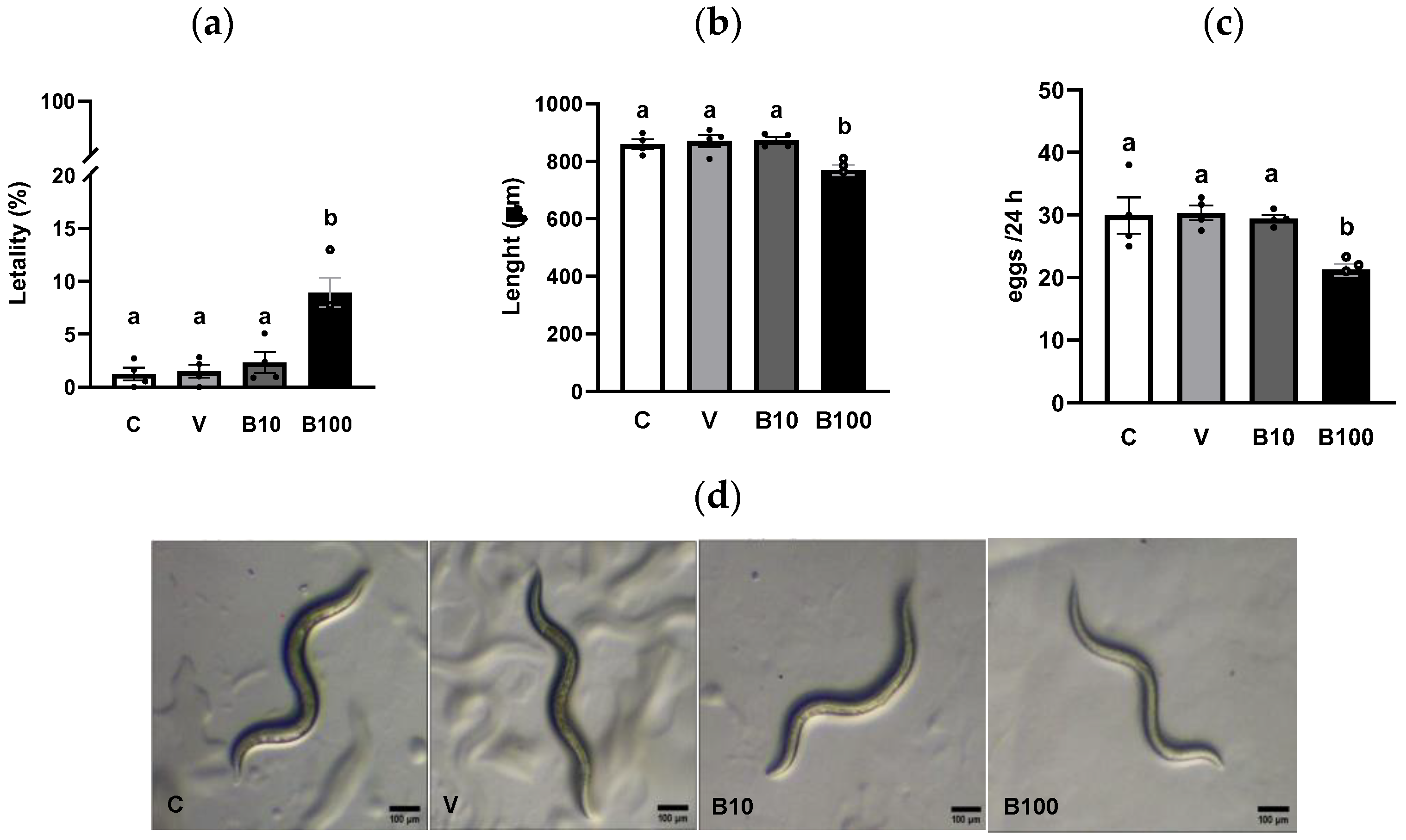
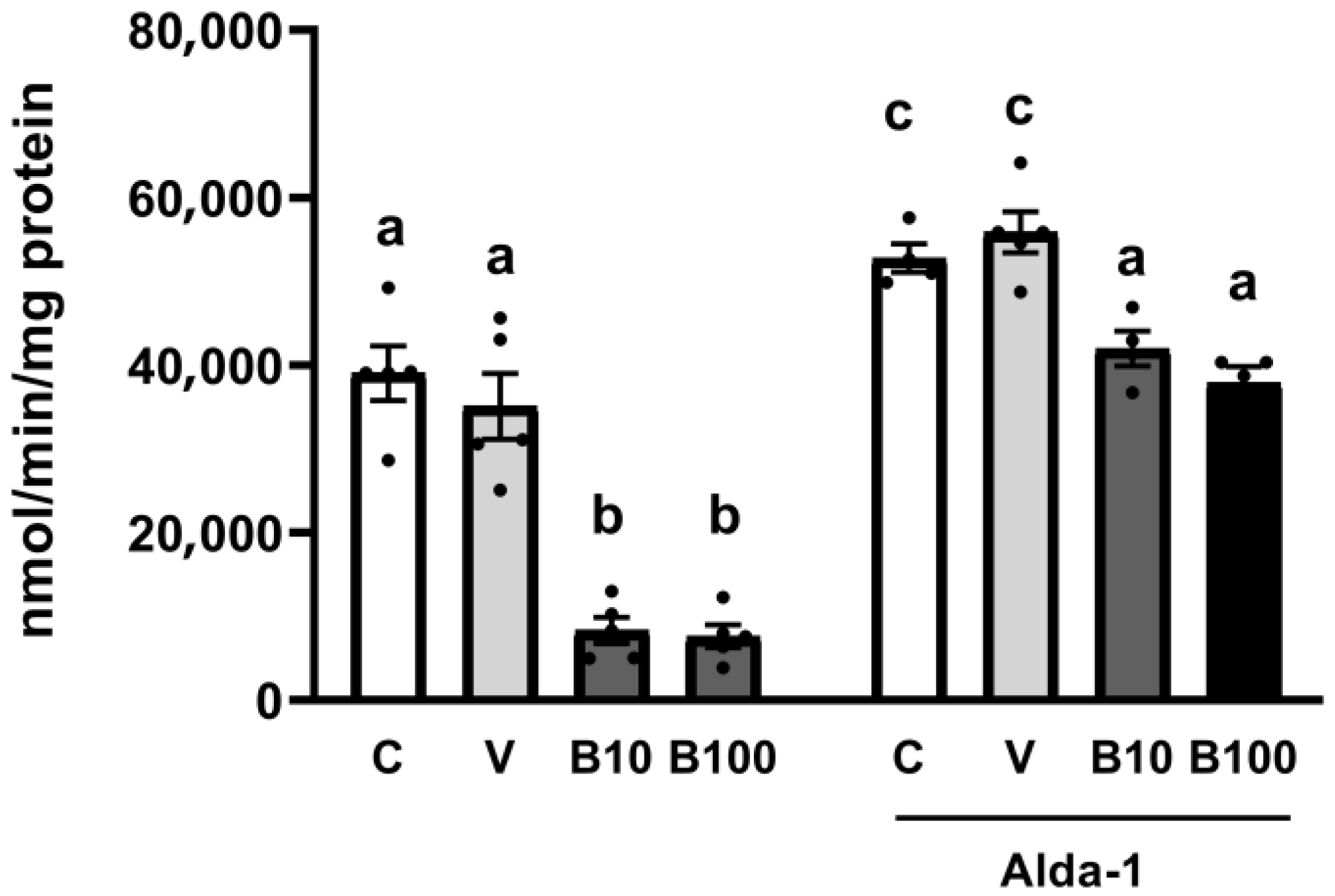

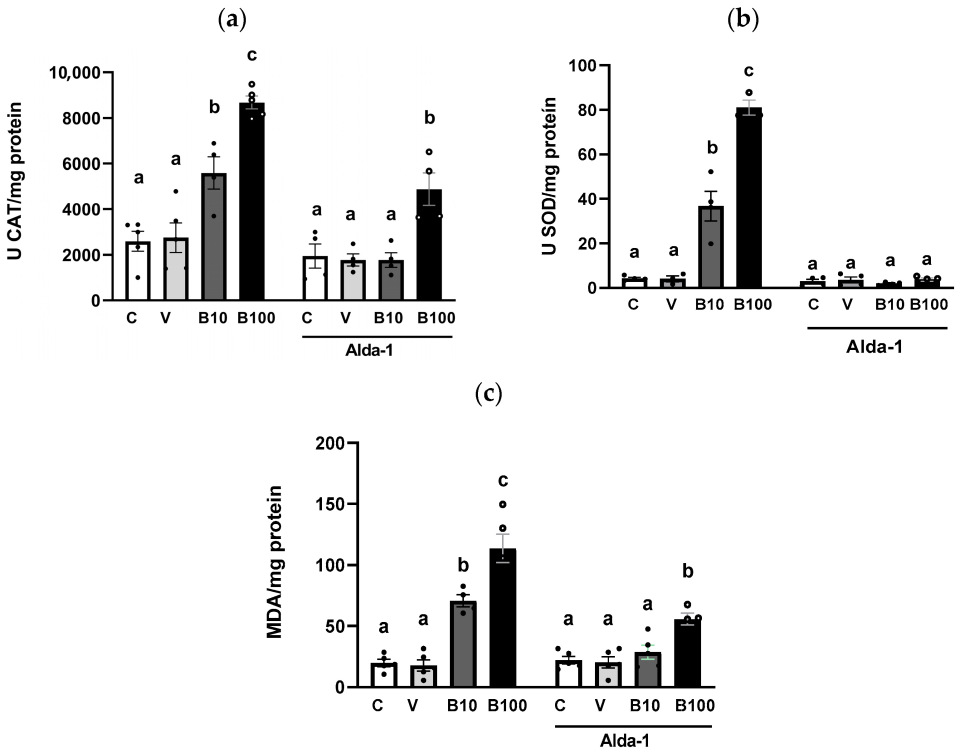
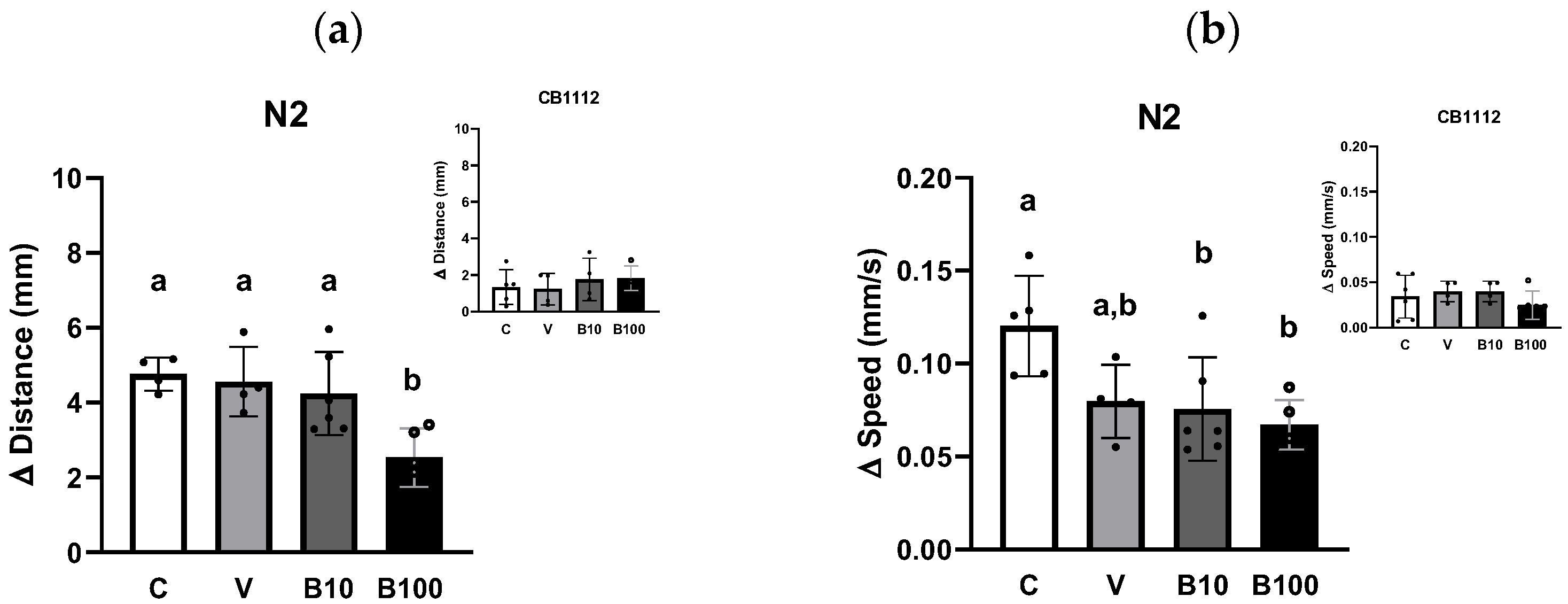

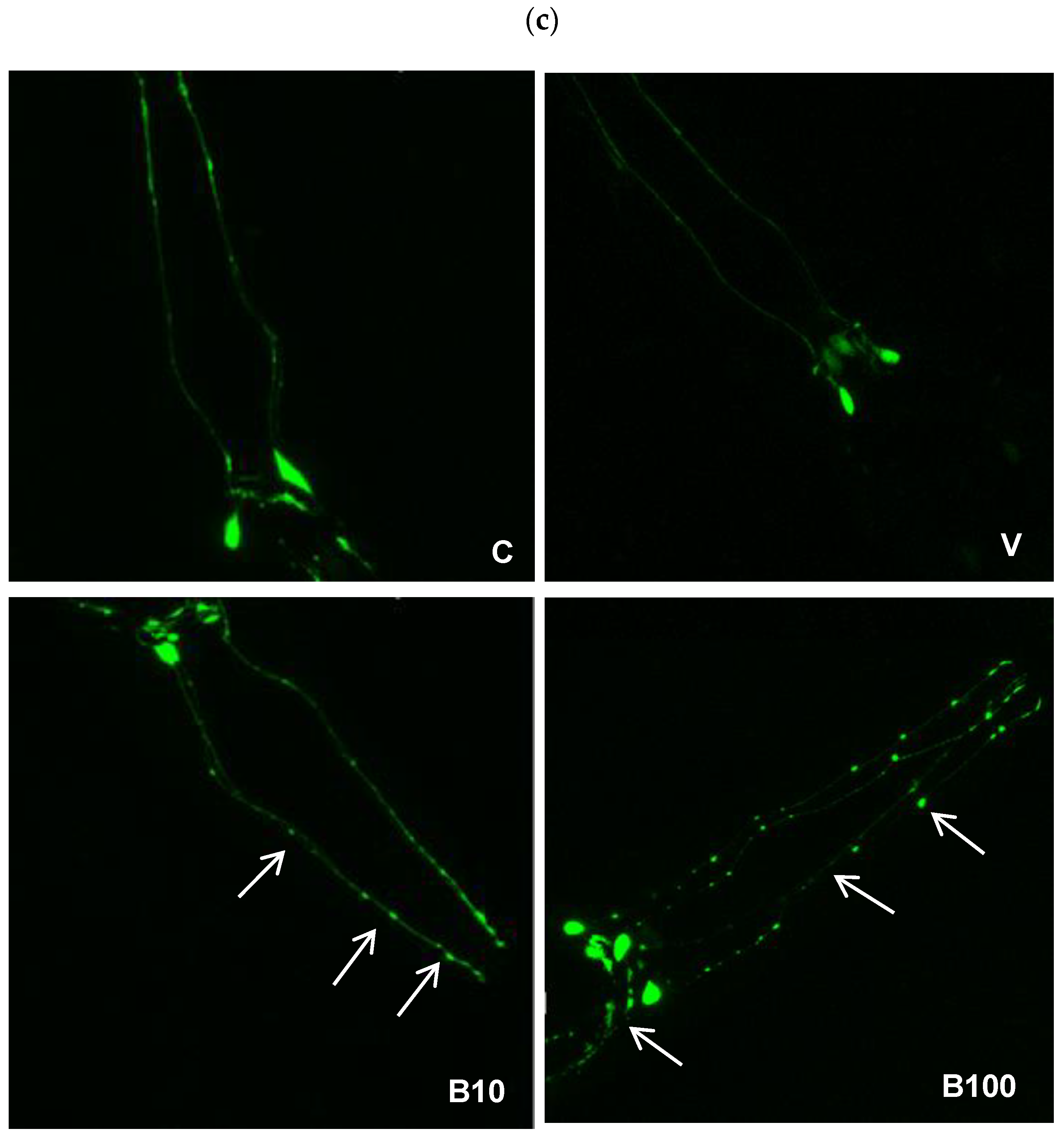
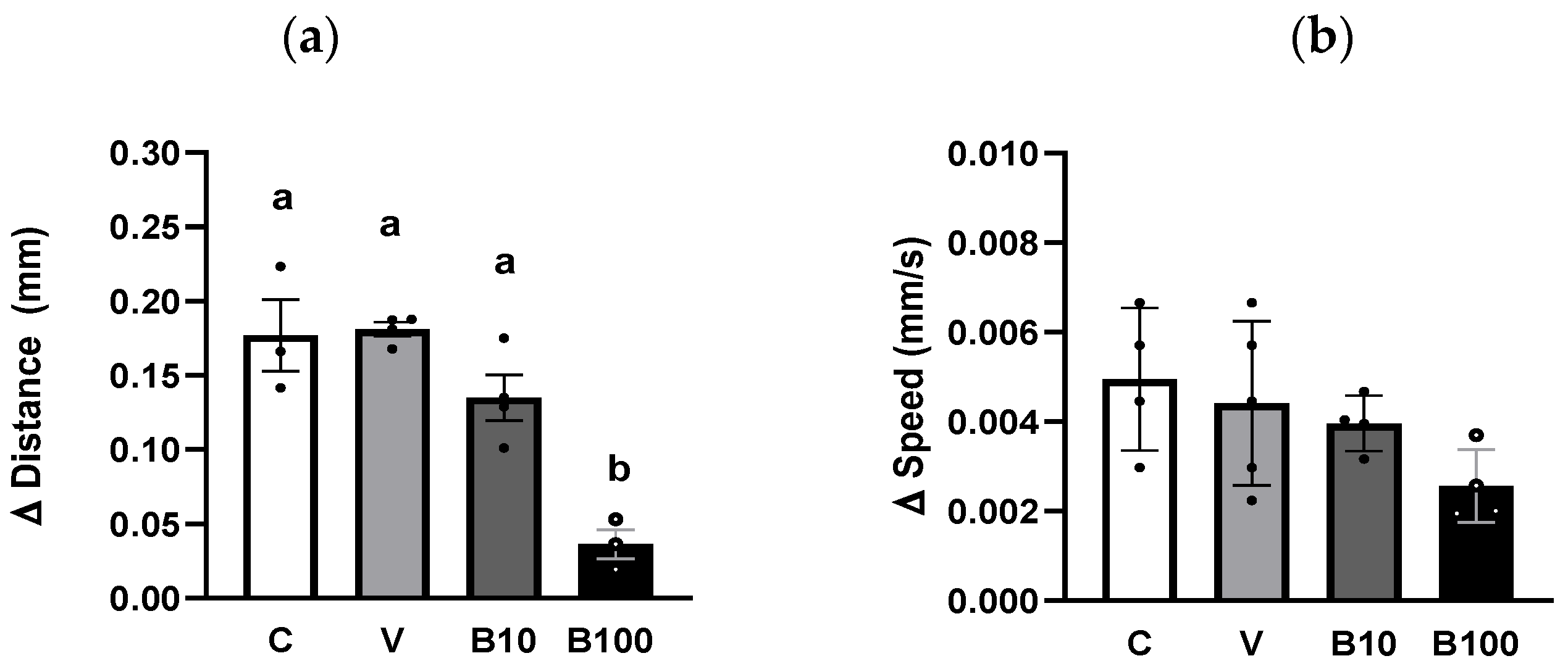
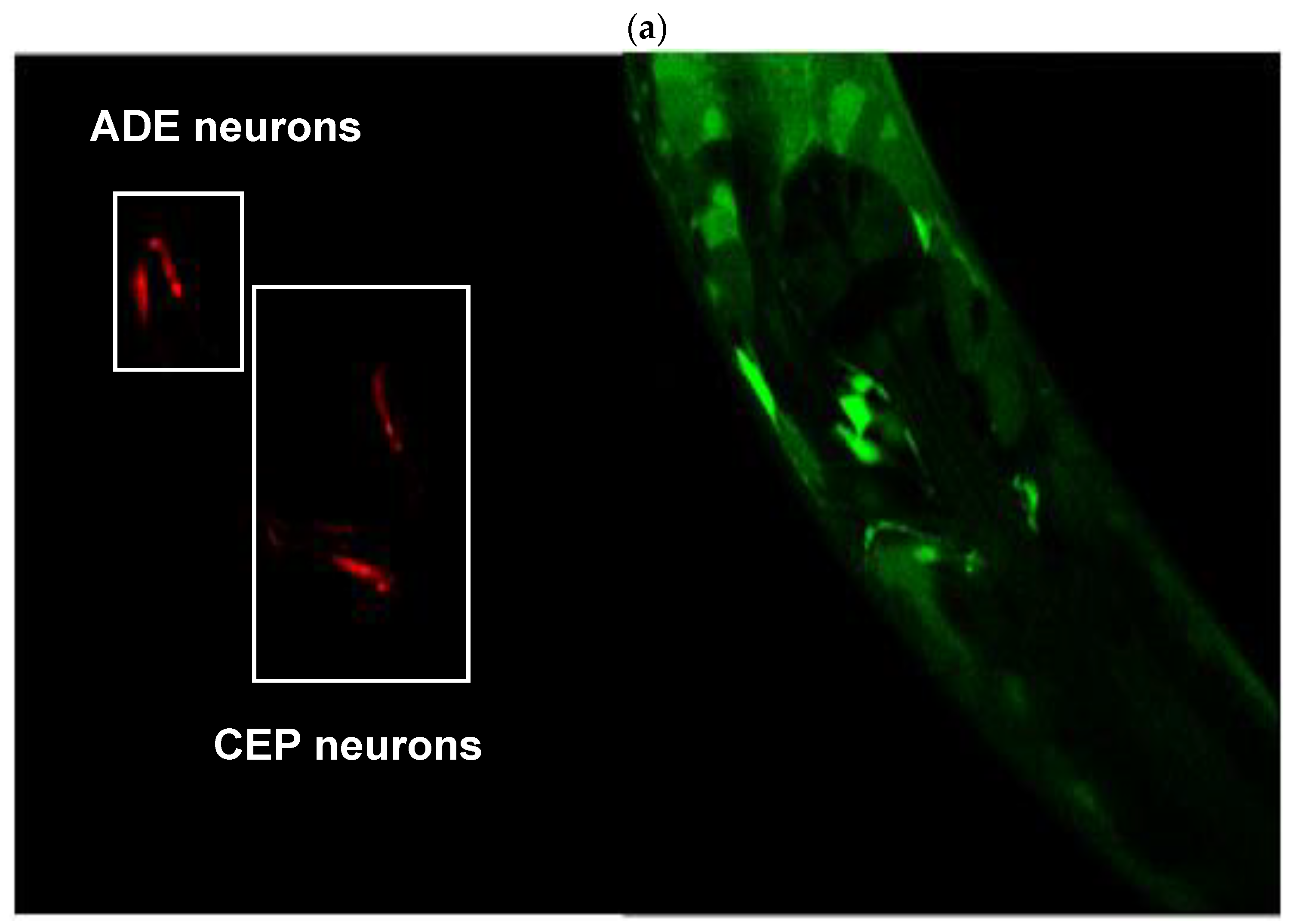
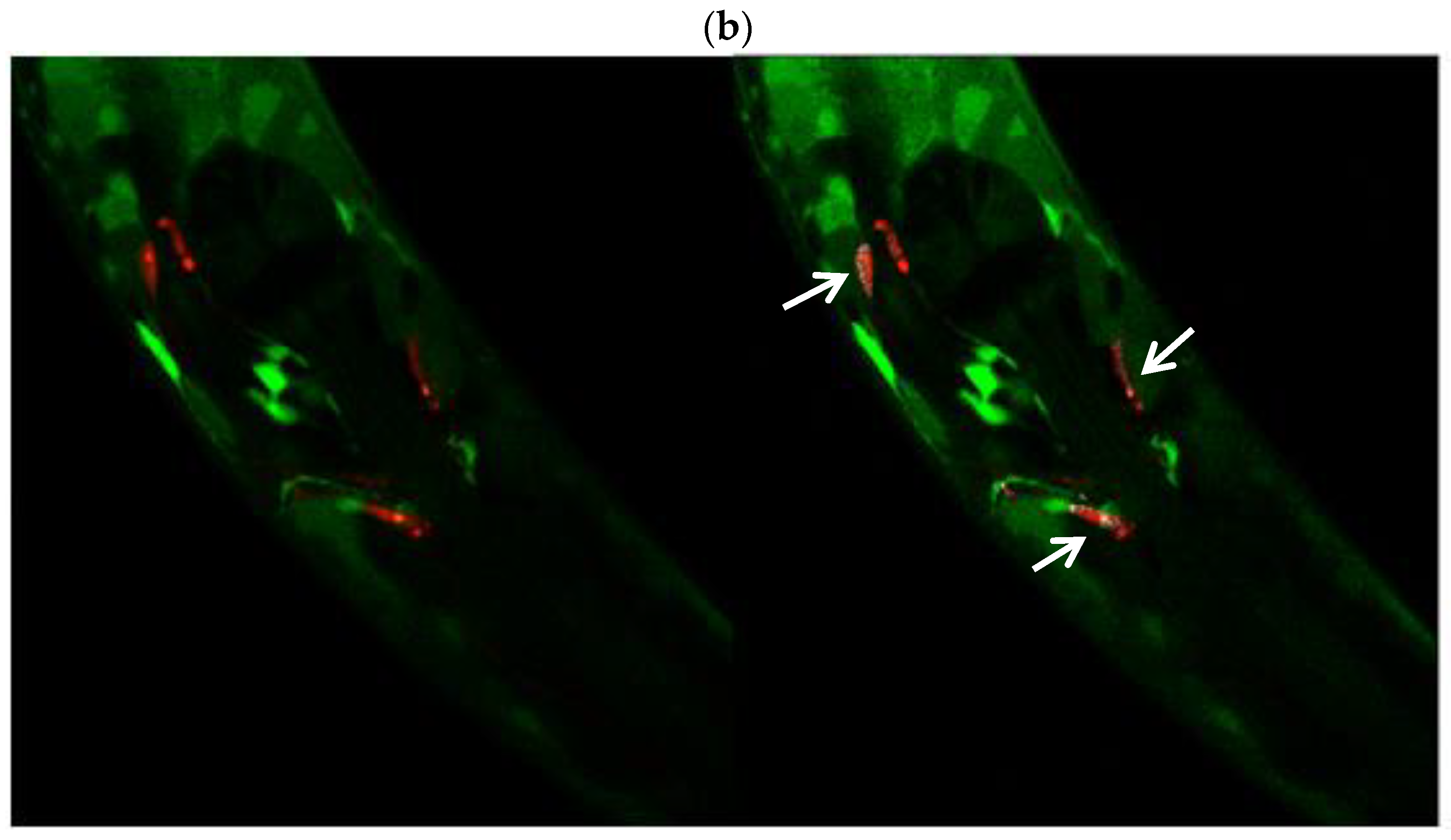
Disclaimer/Publisher’s Note: The statements, opinions and data contained in all publications are solely those of the individual author(s) and contributor(s) and not of MDPI and/or the editor(s). MDPI and/or the editor(s) disclaim responsibility for any injury to people or property resulting from any ideas, methods, instructions or products referred to in the content. |
© 2025 by the authors. Licensee MDPI, Basel, Switzerland. This article is an open access article distributed under the terms and conditions of the Creative Commons Attribution (CC BY) license (https://creativecommons.org/licenses/by/4.0/).
Share and Cite
Fernandez-Hubeid, L.E.; Deza-Ponzio, R.; Albrecht, P.A.; Romero, V.L.; Gonzales-Moreno, C.; Ferreyra, M.R.; Moran, Y.S.; Virgolini, M.B. ALH Inhibition as a Molecular Initiating Event in the Adverse Outcome Pathway of Benomyl Toxicity in Caenorhabditis elegans: Relevance for Parkinsonism. Int. J. Mol. Sci. 2025, 26, 9163. https://doi.org/10.3390/ijms26189163
Fernandez-Hubeid LE, Deza-Ponzio R, Albrecht PA, Romero VL, Gonzales-Moreno C, Ferreyra MR, Moran YS, Virgolini MB. ALH Inhibition as a Molecular Initiating Event in the Adverse Outcome Pathway of Benomyl Toxicity in Caenorhabditis elegans: Relevance for Parkinsonism. International Journal of Molecular Sciences. 2025; 26(18):9163. https://doi.org/10.3390/ijms26189163
Chicago/Turabian StyleFernandez-Hubeid, Lucía Eugenia, Romina Deza-Ponzio, Paula Alejandra Albrecht, Verónica Leonor Romero, Candelaria Gonzales-Moreno, Melisa Rut Ferreyra, Yanina Soledad Moran, and Miriam Beatriz Virgolini. 2025. "ALH Inhibition as a Molecular Initiating Event in the Adverse Outcome Pathway of Benomyl Toxicity in Caenorhabditis elegans: Relevance for Parkinsonism" International Journal of Molecular Sciences 26, no. 18: 9163. https://doi.org/10.3390/ijms26189163
APA StyleFernandez-Hubeid, L. E., Deza-Ponzio, R., Albrecht, P. A., Romero, V. L., Gonzales-Moreno, C., Ferreyra, M. R., Moran, Y. S., & Virgolini, M. B. (2025). ALH Inhibition as a Molecular Initiating Event in the Adverse Outcome Pathway of Benomyl Toxicity in Caenorhabditis elegans: Relevance for Parkinsonism. International Journal of Molecular Sciences, 26(18), 9163. https://doi.org/10.3390/ijms26189163








